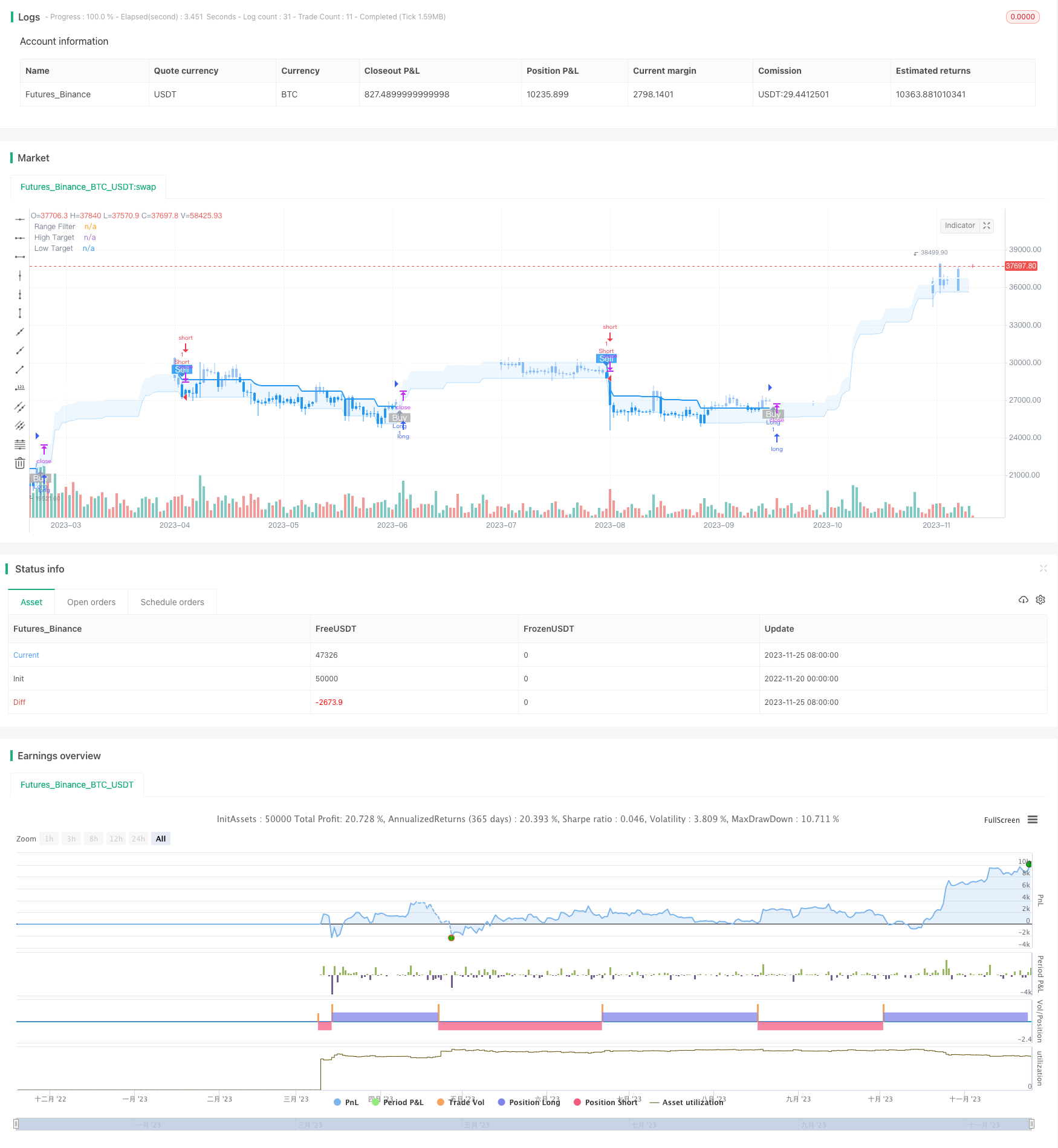
概述
这是一个利用均线和布林通道进行趋势判断,并结合突破过滤和止损原理的策略。它可以在趋势变化时及时捕捉信号,通过双均线过滤减少错误信号,设置止损来控制风险。
策略原理
该策略主要由以下几部分组成:
趋势判断:使用MACD判断价格趋势,区分多头和空头趋势。
范围过滤:使用布林通道判断价格波动范围,过滤掉不突破范围的信号。
双均线确认:快速EMA和慢速EMA组成的双均线,用于确认趋势信号。只有快速EMA>慢速EMA时才产生买入信号。
止损机制:设定止损点,在价格向不利方向突破止损点时平仓止损。
进入信号的判断逻辑是:
- MACD判断为向上趋势
- 价格突破布林通道上轨
- 快速EMA高于慢速EMA
当以上3个条件同时满足时产生买入信号。
平仓逻辑分两种,止盈平仓和止损平仓。止盈点为进入价乘以一定比例,止损点为进入价乘以一定比例。当价格突破其中一个点时平仓。
优势分析
这种策略具有以下优势:
- 能及时捕捉趋势变化,traceback较少。
- 通过双均线过滤错误信号,提高信号质量。
- 止损机制有效控制单笔损失。
- 参数优化空间大,可以调整至最佳状态。
风险分析
该策略也存在一些风险:
- 在震荡行情中产生的错误信号可能造成损失。
- 止损点设置不当可能造成不必要的损失。
- 参数不当可能导致策略效果不佳。
针对这些风险,可以通过优化参数,调整止损位置等方式进行优化和改进。
优化方向
该策略可以从以下几个方向进行优化:
- 调整双均线长度,寻找最佳参数组合。
- 测试不同的止损方式,如追踪止损、震荡止损等。
- 对MACD参数进行测试寻找最优参数。
- 利用机器学习对参数进行自动优化。
- 增加附加条件过滤信号。
通过测试不同的参数设置,评估收益率和夏普比率,可以找到该策略的最佳状态。
总结
这是一个利用趋势判断、范围过滤、双均线确认和止损思想的量化策略。它能够有效判断趋势方向,在利润最大化和风险控制之间找到平衡。通过参数优化和机器学习等方式,该策略还有很大的改进空间,能够得到更好的效果。
策略源码
/*backtest
start: 2022-11-20 00:00:00
end: 2023-11-26 00:00:00
period: 1d
basePeriod: 1h
exchanges: [{"eid":"Futures_Binance","currency":"BTC_USDT"}]
*/
//@version=5
strategy(title="Range Filter Buy and Sell Strategies", shorttitle="Range Filter Strategies", overlay=true,pyramiding = 5)
// Original Script > @DonovanWall
// Adapted Version > @guikroth
//
// Updated PineScript to version 5
// Republished by > @tvenn
// Strategizing by > @RonLeigh
//////////////////////////////////////////////////////////////////////////
// Settings for 5min chart, BTCUSDC. For Other coin, change the parameters
//////////////////////////////////////////////////////////////////////////
SS = input.bool(false,"Percentage Take Profit Stop Loss")
longProfitPerc = input.float(title='LongProfit(%)', minval=0.0, step=0.1, defval=1.5) * 0.01
shortProfitPerc = input.float(title='ShortProfit(%)', minval=0.0, step=0.1, defval=1.5) * 0.01
longLossPerc = input.float(title='LongStop(%)', minval=0.0, step=0.1, defval=1.5) * 0.01
shortLossPerc = input.float(title='ShortStop(%)', minval=0.0, step=0.1, defval=1.5) * 0.01
// Color variables
upColor = color.white
midColor = #90bff9
downColor = color.blue
// Source
src = input(defval=close, title="Source")
// Sampling Period
// Settings for 5min chart, BTCUSDC. For Other coin, change the paremeters
per = input.int(defval=100, minval=1, title="Sampling Period")
// Range Multiplier
mult = input.float(defval=3.0, minval=0.1, title="Range Multiplier")
// Smooth Average Range
smoothrng(x, t, m) =>
wper = t * 2 - 1
avrng = ta.ema(math.abs(x - x[1]), t)
smoothrng = ta.ema(avrng, wper) * m
smoothrng
smrng = smoothrng(src, per, mult)
// Range Filter
rngfilt(x, r) =>
rngfilt = x
rngfilt := x > nz(rngfilt[1]) ? x - r < nz(rngfilt[1]) ? nz(rngfilt[1]) : x - r :
x + r > nz(rngfilt[1]) ? nz(rngfilt[1]) : x + r
rngfilt
filt = rngfilt(src, smrng)
// Filter Direction
upward = 0.0
upward := filt > filt[1] ? nz(upward[1]) + 1 : filt < filt[1] ? 0 : nz(upward[1])
downward = 0.0
downward := filt < filt[1] ? nz(downward[1]) + 1 : filt > filt[1] ? 0 : nz(downward[1])
// Target Bands
hband = filt + smrng
lband = filt - smrng
// Colors
filtcolor = upward > 0 ? upColor : downward > 0 ? downColor : midColor
barcolor = src > filt and src > src[1] and upward > 0 ? upColor :
src > filt and src < src[1] and upward > 0 ? upColor :
src < filt and src < src[1] and downward > 0 ? downColor :
src < filt and src > src[1] and downward > 0 ? downColor : midColor
filtplot = plot(filt, color=filtcolor, linewidth=2, title="Range Filter")
// Target
hbandplot = plot(hband, color=color.new(upColor, 70), title="High Target")
lbandplot = plot(lband, color=color.new(downColor, 70), title="Low Target")
// Fills
fill(hbandplot, filtplot, color=color.new(upColor, 90), title="High Target Range")
fill(lbandplot, filtplot, color=color.new(downColor, 90), title="Low Target Range")
// Bar Color
barcolor(barcolor)
// Break Outs
longCond = bool(na)
shortCond = bool(na)
longCond := src > filt and src > src[1] and upward > 0 or
src > filt and src < src[1] and upward > 0
shortCond := src < filt and src < src[1] and downward > 0 or
src < filt and src > src[1] and downward > 0
CondIni = 0
CondIni := longCond ? 1 : shortCond ? -1 : CondIni[1]
longCondition = longCond and CondIni[1] == -1
shortCondition = shortCond and CondIni[1] == 1
// alertcondition(longCondition, title="Buy alert on Range Filter", message="Buy alert on Range Filter")
// alertcondition(shortCondition, title="Sell alert on Range Filter", message="Sell alert on Range Filter")
// alertcondition(longCondition or shortCondition, title="Buy and Sell alert on Range Filter", message="Buy and Sell alert on Range Filter")
////////////// 副
sensitivity = input(150, title='Sensitivity')
fastLength = input(20, title='FastEMA Length')
slowLength = input(40, title='SlowEMA Length')
channelLength = input(20, title='BB Channel Length')
multt = input(2.0, title='BB Stdev Multiplier')
DEAD_ZONE = nz(ta.rma(ta.tr(true), 100)) * 3.7
calc_macd(source, fastLength, slowLength) =>
fastMA = ta.ema(source, fastLength)
slowMA = ta.ema(source, slowLength)
fastMA - slowMA
calc_BBUpper(source, length, multt) =>
basis = ta.sma(source, length)
dev = multt * ta.stdev(source, length)
basis + dev
calc_BBLower(source, length, multt) =>
basis = ta.sma(source, length)
dev = multt * ta.stdev(source, length)
basis - dev
t1 = (calc_macd(close, fastLength, slowLength) - calc_macd(close[1], fastLength, slowLength)) * sensitivity
e1 = calc_BBUpper(close, channelLength, multt) - calc_BBLower(close, channelLength, multt)
trendUp = t1 >= 0 ? t1 : 0
trendDown = t1 < 0 ? -1 * t1 : 0
duoad = trendUp > 0 and trendUp > e1
kongad = trendDown > 0 and trendDown > e1
duo = longCondition and duoad
kong = shortCondition and kongad
//Alerts
plotshape(longCondition and trendUp > e1 and trendUp > 0 , title="Buy Signal", text="Buy", textcolor=color.white, style=shape.labelup, size=size.small, location=location.belowbar, color=color.new(#aaaaaa, 20))
plotshape(shortCondition and trendDown > e1 and trendDown > 0 , title="Sell Signal", text="Sell", textcolor=color.white, style=shape.labeldown, size=size.small, location=location.abovebar, color=color.new(downColor, 20))
if longCondition and trendUp > e1 and trendUp > 0
strategy.entry('Long',strategy.long, comment = "buy" )
if shortCondition and trendDown > e1 and trendDown > 0
strategy.entry('Short',strategy.short, comment = "sell" )
longlimtPrice = strategy.position_avg_price * (1 + longProfitPerc)
shortlimtPrice = strategy.position_avg_price * (1 - shortProfitPerc)
longStopPrice = strategy.position_avg_price * (1 - longLossPerc)
shortStopPrice = strategy.position_avg_price * (1 + shortLossPerc)
if (strategy.position_size > 0) and SS == true
strategy.exit(id="Long",comment_profit = "Profit",comment_loss = "StopLoss", stop=longStopPrice,limit = longlimtPrice)
if (strategy.position_size < 0) and SS == true
strategy.exit(id="Short",comment_profit = "Profit",comment_loss = "StopLoss", stop=shortStopPrice,limit = shortlimtPrice)